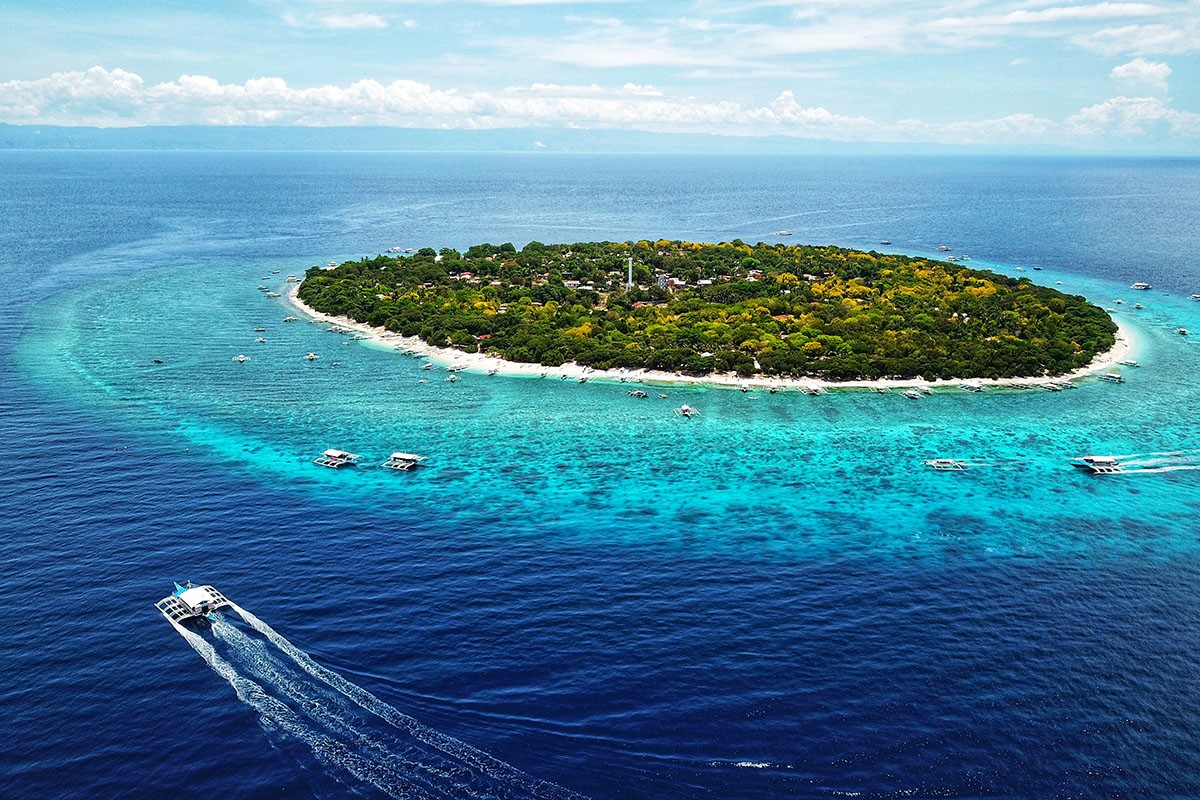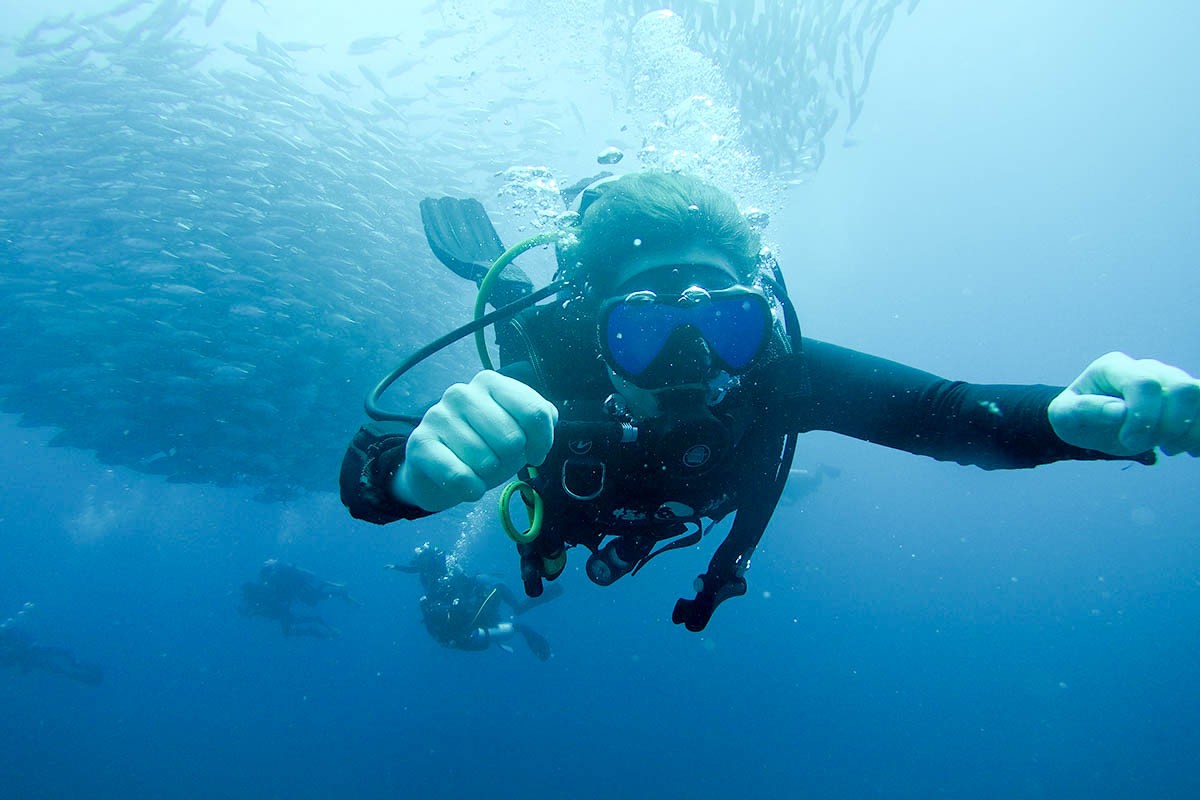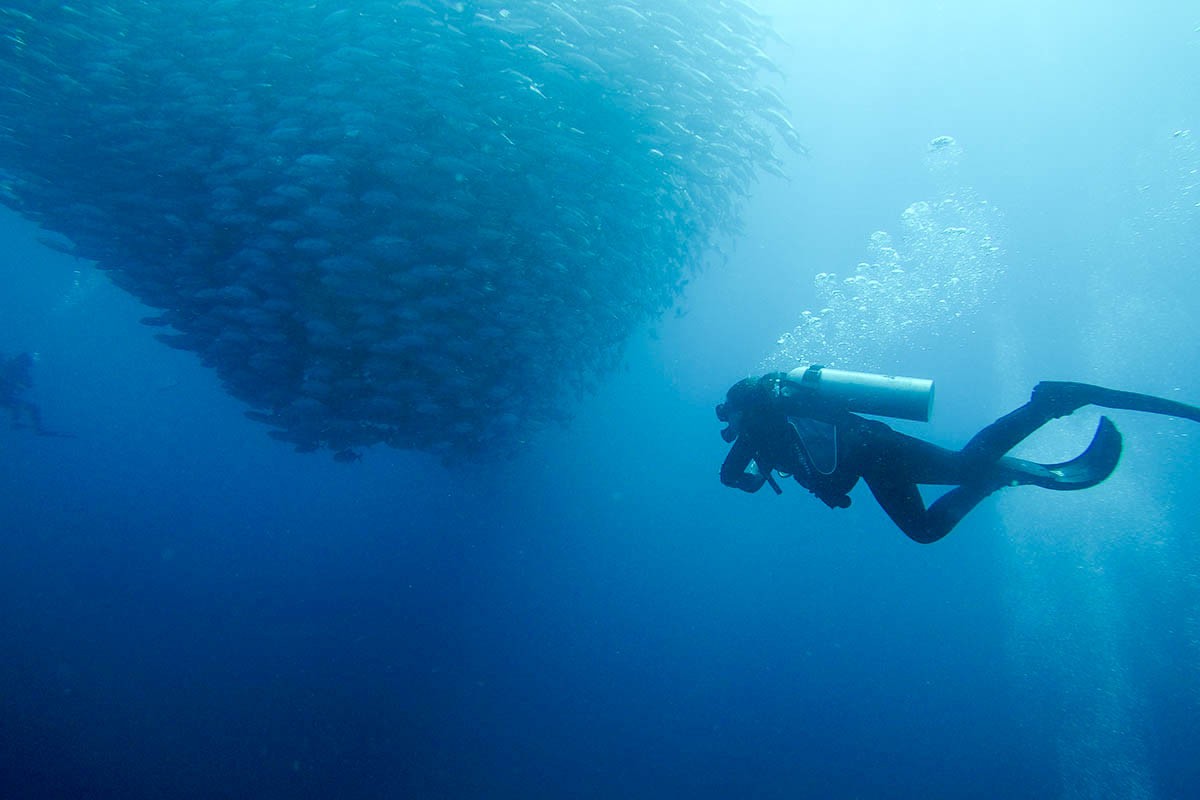With more than 7,000 islands – and they’re finding new ones all the time – the Philippines is certainly not short of tropical beaches. And where there are tropical beaches, there’s often amazing diving. The Philippines is no exception to this.
There are plenty of amazing places to dive in the Philippines – and the best place for you to dive largely depends on what you’re looking for. If you want to dive shipwrecks, go to Coron. If you’re seeking out thresher sharks, head to Malapascua.
However, if you’re just after coral and lots of marine life, and maybe getting a diving certification, diving in Bohol might be your best answer.
Where is Bohol?
Located a convenient two hour ferry ride from Cebu, the Philippines’ second largest city, Bohol is a perfect island getaway. It’s big enough to have lots of things to do, but small enough to have distinct island vibes.
Panglao, which is actually an island in itself that is connected to Bohol by a bridge is where the dive sites are all located. So when I talk about diving in Bohol, I actually mean diving in Panglao – but the instructions are still the same!
You can use Bookaway to book transport to Bohol. Click here to browse your options.
How to Get to Bohol and Panglao
As mentioned, Bohol is located two hours south of Cebu, and getting to Bohol from Cebu City is very easy. You just need to head to Cebu City Pier 1 – you can take a Grab taxi there from your accommodation or the airport, if you arrive early enough – and buy a ticket for Tagbilaran, which is the main city in Bohol.
Ferries leave around every hour until 5 or 6pm. There are a few companies who ply the route, but Ocean Jet is the most popular. I took Ocean Jet on the way to Bohol and travelled back with Island Water – the ticket was slightly more expensive and took longer, but the boat was much more luxurious, and weirdly almost empty – I had the entire front section to myself!
My horrendously jet-lagged self managed to negotiate this boat on my very first day in the Philippines, so it really is quite simple. However, if you want to book your tickets in advance, you can do so through Bookaway. Click here to browse transport tickets for the Philippines.
Once in Tagbilaran, you’ll need to get to Panglao. I didn’t have any luck with Grab here so ended up getting a transfer for 600 pesos – which was quite expensive (although it was just me in a van, if I was travelling with people this could have obviously been split!).
On the way back from Panglao to the pier, my guesthouse’s neighbour took me on his bike for 200 pesos. So ask around, and be prepared to pay a little more if you’re travelling solo.
Diving in Bohol: The Dive Sites
Once you arrive in Bohol, you’ll probably be wondering how to sort out your diving! The most popular dive sites in Bohol are Balicasag, which is famous for turtles, and Pamilican which has a rich variety of marine life and is close to Pamilican Island. There is also a wreck, which is mainly used for the advanced diving qualification, and other smaller diving sites that you can be taken to on request.
Balicasag
Most famous for turtles, Balicasag is a marine park located by an island with the same name. There is plenty to see in this area, with various dive sites including:
- Black Forest with lots of black coral
- Turtle Point, where there are (obviously) lots of turtles!
- Catherdral Wall where you can see different fish within the rocky crevices
- Marine Sanctuary, where there is also a wall dive and diversity of fish
Pamilican
Make sure you have a good quality selfie stick – depending on the time of year, you might get the chance to see dolphins, whales and whale sharks at Pamilican! Manta rays are also commonly spotted here throughout the year. Diving at Pamilican will also give you the chance to enjoy a diversity of marine life, year round. There can be strong currents at Pamilican, meaning your dive might turn into a drift dive!
When I went diving at Pamilican, we enjoyed lunch on the island and had a chance to walk around it; it’s a really tranquil place and nice to experience!
Which School for Diving in Panglao?
I used and recommend Blue Revival Dive School. They are a professional and friendly school who make safety their first priority but also are fantastic diving instructors.
Confession: I was not a confident diver. In the past I’ve got very anxious about diving, I’ve freaked out about why I forced myself underwater when that feels SO unnatural, and when I’ve been actually underwater sometimes I’ve had mini panics about the fact that I’m relying on a tank on my back for air, whether I might suffer from decompression sickness, or if I’ve burst an eardrum.
It sounds strange that I’ve carried on diving after all of this anxiety, but for every bad diving experience I had a good one, and I knew that the more I practiced the more I’d get used to it, stop freaking out and appreciate diving for the epic activity it is.
Doing my advanced diving qualification with Blue Revival improved my diving confidence and skills SO much. I relaxed about 500x more, I finally perfected my buoyancy and movement underwater, and I actually looked (and felt) like I was actually enjoying myself rather than spending 45 minutes wondering if my lungs were going to explode (a genuine worry I’ve had while diving before).
Blue Revival diving school are also dedicated to marine conservation, and speak out about unethical marine practices like whale shark diving in Oslob. Part of your fee goes to helping the dogs of Alona – feeding and getting them vaccinated, which makes Panglao a safer place for all.
The advanced diving qualification encompassed a deep-sea dive, a night dive, a navigation dive and a buyoancy dive. Another can be chosen from a selection of optional dives. These took place closer to Panglao’s shores, however the dive sites were still spectacular – I dived along a sea wall and saw some fascinating sea life. Blue Revival also do open water qualifications.
During the fun dives, I checked out Bohol’s main dive sites, and saw a shoal of black fish, as well as dozens of turtles, sea snakes and much more.
The coral in Bohol is a lot more vibrant than other places in South East Asia (like Thailand and Bali!) and the range of aquatic life here is some of the best I’ve experienced.
Where to Stay in Bohol
Hostel: Glamping Alona is great for a beachy stay in Bohol, with features like a restaurant and bar and pool. Even though it has a range of facilities, it is perfect for the budget backpacker, with dorm beds starting at 10 USD per night. Click here for rates and to book.Guesthouse: I stayed in Walkerz Inn for my last night in Panglao, when I wanted to be a bit closer to Alona Beach. It is in a rustic setting with small huts, with shared bathrooms. I got my own hut, but it was attached to the neighbouring hut, meaning that it could be quite noisy when my neighbours were talking! Breakfast is included and the staff, like all Filipinos, are absolutely lovely. They also arranged me a cheap transfer back to Taglibaran for the ferry. Click here for rates and to reserve.
Mid-Range Hotel: I stayed in Cliffside Resort for four nights, and enjoyed really enjoyed it. The resort has rooms focused around a pool, and a restaurant and pool bar, and it’s possibly the best place on the island for magical sunsets. Click here to read more and to reserve.
Luxury Hotel: South Palms Resort Panglao is one of the best resorts on the island. With private luxury villas, a spa and gorgeous tropical island surroundings, the resort is an example of amazing Filipino hospitality. Click here for rates and to book your stay.
Other things to do in Bohol
Apart from enjoying the marine life of Bohol, there are a few things to enjoy on this Philippine island. The main things are to enjoy the beach and to see the countryside.
Alona Beach is one of the best tourist spots in Bohol. It is the most popular beach on the island, and it’s a great place to grab a beer, watch the sunset and sunbathe. There are, of course, lots of other beaches all over the island as well! When night comes, you can enjoy the bars and restaurants of Alona, including Ken’s which has a quiz on Thursday nights. There’s also a fantastic vegan restaurant near Alona – which is a bit of a rarity for the Philippines – called Shaka.
Enjoying the countryside is a great thing to do in Bohol. You can either rent a motorbike and explore independently, or do a countryside tour. Tours go to the Chocolate Hills, to Tarsier sanctuaries (they’re the smallest marsupial on the planet and they’re only found in South East Asian island) and a buffet boat ride along a river, amongst other things. I did the countryside tour, and it was a fun, cheap way to see all the attractions. Click here to book a Bohol countryside tour via Klook.
Packing List for Diving in Bohol
Below are some things that I would highly recommend for diving in Bohol. You can click through on each item to purchase.
- Reef-safe sunscreen
- A Go-Pro and Diving Case
- A Water to Go Bottle, so you can drink the tap water in Bohol
- Your own diving equipment, if you are a serious diver and prefer to dive with your own stuff
Other Philippines Posts
During my first trip to the Philippines, I visited Bohol, Manila, Pampanga, Boracay, Panay, Davao and Zamboanga – you can expect posts for most of these destinations soon, so do check back!
In the meantime, are you heading elsewhere in South East Asia? I have itineraries for Bali, Java, Singapore, Malaysia (coming soon!), Thailand, Laos, Cambodia, Vietnam and China.
If you enjoyed this post, please share it or follow me on Instagram for more!






